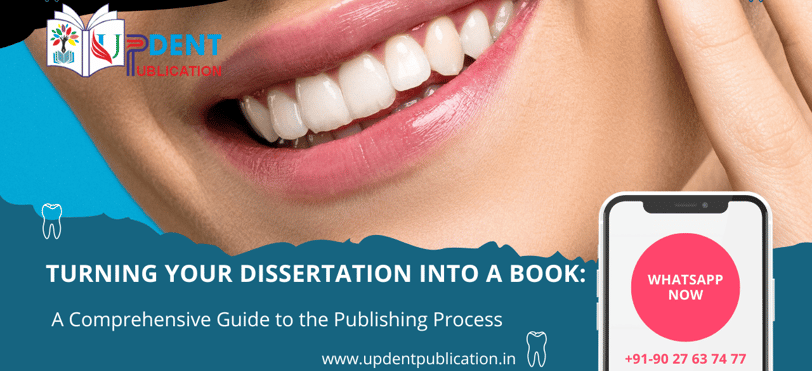Updent Publication: Where Knowledge Meets Innovation.
Turning Your Dissertation into a Book: A Comprehensive Guide to the Publishing Process
Can I Publish My Thesis/ Dissertation as a Book?
#DENTAL LIBRARY DISSERTATIONS#DENTAL BOOK PUBLICATION
Updent Publication
3/19/20253 min read


Turning Your Dissertation into a Book: A Comprehensive Guide to the Publishing Process
Completing a dissertation is a monumental achievement, but sharing your hard work with the world can be equally gratifying. One of the most effective ways to do so is by transforming your dissertation into a book. While this journey may seem challenging, it is both enriching and rewarding if approached methodically. Let’s explore the steps to publish your dissertation as a book and maximize its impact.
Can I Publish My Thesis/ Dissertation as a Book?
Yes, your dissertation can become a published book! This involves several steps that ensure your research appeals to a broader audience. Here’s how to get started:
1. Assess the Viability of Your Dissertation for Publication: Not all dissertations are destined to become books. Begin by evaluating whether your work has the potential to attract readers outside academia. Research the market demand for your topic by examining similar books in your field and studying their performance. If there’s a demand for your research area, your dissertation could make a successful book.
2. Edit and Adapt Your Dissertation: Dissertations are often dense and tailored for academic purposes, whereas books require a more engaging and reader-friendly tone. Revise your content to make it accessible and appealing to a broader audience. You may consider restructuring chapters, reducing technical jargon, or emphasizing key findings. Hiring a professional editor can be immensely beneficial in refining your manuscript.
3. Identify the Right Publisher: Selecting the right publisher is crucial to your success. There are three main routes to consider:
- Traditional Publishers: These include academic and trade publishers.
- Self-Publishing: Offers full control over the process and faster publishing timelines.
- Hybrid Publishers: Combine aspects of both traditional and self-publishing models.
For example, Updent Publication provides authors with comprehensive support to transform their academic work into published books. They offer tailored services that simplify the process and ensure quality publishing.
4. Understand Submission Guidelines: Each publisher has specific requirements, such as formatting, word count, and style guidelines. It is essential to adhere to these instructions meticulously to improve your chances of acceptance and reduce delays.
5. Build Your Author Brand and Platform: A successful book requires a robust promotional strategy. Start building your presence as an author by:
- Creating a website that showcases your research and expertise.
- Engaging with your audience on social media.
- Networking with other authors, scholars, and influencers in your field.
Building a strong author platform will amplify your book’s visibility and readership once it’s published.
6. Exercise Patience During the Process: Publishing is not an overnight task. From manuscript submission to final production, the process can take several months or even years. However, the fulfillment of seeing your dissertation transformed into a tangible book is well worth the wait.
Publishing Your Dissertation in a Journal
Another impactful way to share your research is by publishing your dissertation in a peer-reviewed journal like a Journal of Clinical Dentistry- Heal Talk, a Journal of Advanced Dentistry-Updent.
Here’s how you can navigate this process:
1. Research and Choose the Right Journal: Identify journals that align with your field of research. Look for publications that have previously featured articles similar to your dissertation topic. A well-targeted journal increases the likelihood of acceptance.
2. Review and Follow Submission Guidelines: Every journal has unique submission guidelines, including requirements for formatting, word limits, and citation styles. Carefully review these instructions to ensure compliance.
3. Adapt Your Dissertation for a Journal Article: A dissertation and a journal article serve different purposes. While your dissertation might be comprehensive, journal articles need to be concise and focused on specific aspects of your research. Extract the most compelling sections, streamline your findings, and refine your writing style to fit the journal’s format.
4. Write a Strong Cover Letter: Accompany your submission with a well-crafted cover letter. Highlight the significance of your research, its relevance to the journal’s audience, and how it contributes to the existing body of knowledge. A persuasive cover letter can make a strong first impression.
5. Navigate the Peer-Review Process: Once submitted, your article will undergo a peer-review process, where experts in your field evaluate its quality and significance. Be prepared to receive constructive feedback and make revisions as needed.
6. Ensure Credibility and Build Trust: Positioning your dissertation as an authoritative and reliable piece of research enhances its appeal to journals. Establish credibility by showcasing the originality and validity of your findings.
Reap the Rewards of Publishing
Publishing your dissertation-whether as a book or a journal article-is a rewarding endeavor that amplifies the impact of your work. It allows you to share your findings with a broader audience, gain recognition in your field, and even open doors to new opportunities such as teaching, consulting, or further research.
By following these steps and partnering with a reputable publisher like Updent Publication, you can navigate the publishing process with confidence. Transform your hard work into a lasting legacy that informs and inspires others!!!!!
